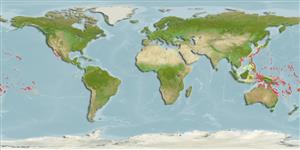>
Blenniiformes (Blennies) >
Tripterygiidae (Triplefin blennies) > Tripterygiinae
Etymology: Enneapterygius: Greek, ennea = nine times + Greek, pterygion = little fin (Ref. 45335); nigricauda: Specific name refers to the black caudal fin of the males.
More on author: Fricke.
Environment: milieu / climate zone / depth range / distribution range
Écologie
marin démersal; profondeur 0 - 11 m (Ref. 27223). Tropical
Western Central Pacific: Taiwan, Philippines, Vanuatu, Tonga, American Samoa, Society Islands, Kiribati, Jarvis Island, Howland Island, Wake Island, Marshall Islands, Micronesia, Guam, and Boni Islands (Japan).
Taille / Poids / Âge
Maturity: Lm ? range ? - ? cm
Max length : 2.9 cm SL mâle / non sexé; (Ref. 27223)
Description synthétique
Clés d'identification | Morphologie | Morphométrie
Épines dorsales (Total) : 14 - 17; Rayons mous dorsaux (Total) : 7 - 10; Épines anales: 1; Rayons mous anaux: 16 - 19. Male red with darker red, double red bars , black "mask" covering front and lower two-thirds of head, chest, and pectoral-fin base, narrow white bar at caudal-fin base, and basal two-thirds to three-fourths of caudal-fin black. Female translucent greenish grey with indistinct reddish blotches along back, middle of sides, and just above anal-fin base. Head, chest, and pectoral-fin base scaleless; short orbital tentacle present; mandibular pores 3-4 + 1 + 3-4. Maximum size to 3.5 cm TL (Ref. 90102).
Adults are found on seaward and lagoon reefs, usually less than 5 m (Ref. 90102). Eggs are hemispherical and covered with numerous sticky threads that anchor them in the algae on the nesting sites (Ref. 240). Larvae are planktonic which occur primarily in shallow, nearshore waters (Ref. 94114). Minimum depth from Ref. 58018.
Life cycle and mating behavior
Maturité | Reproduction | Frai | Œufs | Fécondité | Larves
Fricke, R., 1997. Tripterygiid fishes of the western and central Pacific, with descriptions of 15 new species, including an annotated checklist of world Tripterygiidae (Teleostei). Theses Zool. 29:1-607. (Ref. 27223)
Statut dans la liste rouge de l'IUCN (Ref. 130435: Version 2024-2)
Menace pour l'homme
Harmless
Utilisations par l'homme
Pêcheries: sans intérêt
Outils
Articles particuliers
Télécharger en XML
Sources Internet
Estimates based on models
Preferred temperature (Ref.
123201): 24.6 - 29.3, mean 28.3 °C (based on 1661 cells).
Phylogenetic diversity index (Ref.
82804): PD
50 = 0.5000 [Uniqueness, from 0.5 = low to 2.0 = high].
Bayesian length-weight: a=0.00617 (0.00288 - 0.01322), b=3.04 (2.86 - 3.22), in cm total length, based on LWR estimates for this (Sub)family-body shape (Ref.
93245).
Niveau trophique (Ref.
69278): 3.1 ±0.3 se; based on size and trophs of closest relatives
Résilience (Ref.
120179): Haut, temps minimum de doublement de population inférieur à 15 mois (Preliminary K or Fecundity.).
Fishing Vulnerability (Ref.
59153): Low vulnerability (10 of 100).
